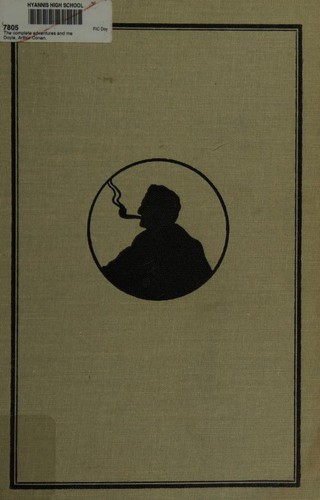Rigidkovrila, 326 paĝoj
Lingvo: English
Eldonita je 22-a de novembro 1975 de Bramhall House.

Rigidkovrila, 326 paĝoj
Lingvo: English
Eldonita je 22-a de novembro 1975 de Bramhall House.
Here is Sherlock Holmes in his original, classic set- ting: the pages of The Strand Magazine, the stage from which he made his debut in 1891, and from which Arthur Conan Doyle chose to lay him to rest—albeit temporarily—in 1893.
These are the most beloved of the Sherlock Holmes stories, the ones written in the first flush of Arthur Conan Doyle's genius. There are' twenty-four stories here, and between "A Scandal in Bohemia" and "The Final Problem" there lie such masterpieces as "The Red-Headed League," "The Adventure of the Speckled Band," "The Five Orange Pips," "The Adventure of the Silver Blaze," and "The Adventure of the Musgrave Ritual."
This edition includes "The Cardboard Box," originally withheld from publication by Conan Doyle, who thought that he had perhaps gone too far in dealing with premarital sex.
The idea of writing a series of short stories around one central character was a …
Here is Sherlock Holmes in his original, classic set- ting: the pages of The Strand Magazine, the stage from which he made his debut in 1891, and from which Arthur Conan Doyle chose to lay him to rest—albeit temporarily—in 1893.
These are the most beloved of the Sherlock Holmes stories, the ones written in the first flush of Arthur Conan Doyle's genius. There are' twenty-four stories here, and between "A Scandal in Bohemia" and "The Final Problem" there lie such masterpieces as "The Red-Headed League," "The Adventure of the Speckled Band," "The Five Orange Pips," "The Adventure of the Silver Blaze," and "The Adventure of the Musgrave Ritual."
This edition includes "The Cardboard Box," originally withheld from publication by Conan Doyle, who thought that he had perhaps gone too far in dealing with premarital sex.
The idea of writing a series of short stories around one central character was a new one in England. With the success of the first Strand story, "A Scandal in Bohemia," Doyle was encouraged to write a series of six, for which he agreed to be paid an average of $175 each. In a matter of days he had written the first series. Sherlock Holmes burst into tremendous popularity, and Doyle raised his price to $250 a story. He finished the next six in rapid time and wrote to his mother "I think of slaying Holmes in the last and winding him up for good. He takes my mind from bet- ter things."
The Strand continued to hound Conan Doyle for more about Holmes. The offer of much greater amounts of money disturbed the spiritual side of Conan Doyle as much as did his overexposure to Holmes. Doyle had found the perfect cliff from which to propel the detective, and did so in "The Final Problem." The resulting public outcry shocked him. Doyle was looked upon as an assassin; people wept; men wore mourning bands to their offces, and Doyle was called a brute by at least one outraged reader. The stories themselves have been translated into forty-one languages, including Basuto and shorthand. Ellery Queen contended that "more has been written about Sherlock Holmes than any other character in fiction."
Sherlock Holmes is, said Sherlockian scholar Edgar W. Smith, "the personification of something in us that we have lost, or never had. For it is not Sherlock Holmes who sits in Baker Street, comfortable, competent and self-assured; it is ourselves who are there, full of a tremendous capacity for wisdom, complacent in the presence of our humble Watson, conscious of a warm well-being and a timeless, imperishable content. The easy chair in the room is drawn up to the hearth- stone of our very hearts—it is our tobacco in the Persian slipper, and our violin lying so carelessly across the knees—it is we who hear the pounding on the stairs and the knock upon the door. The swirling fog without and the acrid smoke within bite deep in- deed, for we taste them even now. And the time and place and all the great events are near and dear to us not because our memories call them forth in pure nostalgia, but because they are a part of us today. "That is the Sherlock Holmes we love—the Holmes implicit and eternal in ourselves."
Sidney Paget, the illustrator for The Strand stories, was commissioned in error. The editors were under the mistaken impression that they were writing to his artist brother, Walter, who had made the drawings for Sir H. Rider Haggard's King Solomon's Mines and She, and was perhaps best known for his illustrations for Robinson Crusoe and Treasure Island. Sidney Paget was successful as a painter, having shown two pictures at the Academy when he was only eighteen years old. He began painting portraits and small pictures at the same time as he was illustrating books and papers, chiefly war subjects of Egypt and the Sudan. Walter Paget, who lost the chance to be Holmes' Strand illustrator, did serve as model for his brother's successful attempts at bringing Holmes to life. Paget produced a total of 357 Sherlock Holmes drawings with Conan Doyle complaining that Paget had made Holmes far handsomer than his creator had ever in- tended him to be. --jacket